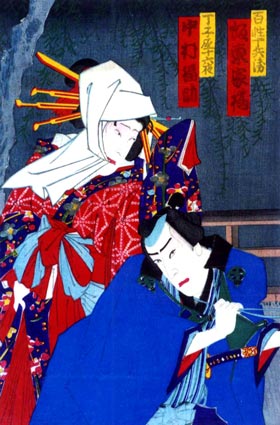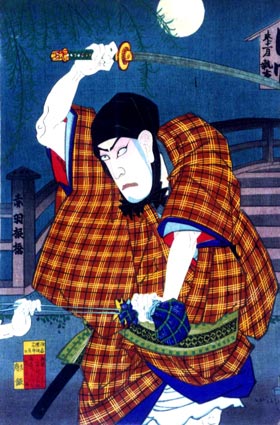| MURAI CHďAN |
| Play title | Kanzen Ch˘aku Nozoki Garakuri Urami Kuzu Tsuyu-ni Nureginu |
|||||||||||||||||||||||||||||||||||||||||||||
| Author | Kawatake Shinshichi II | |||||||||||||||||||||||||||||||||||||||||||||
| History |
"Kanzen Ch˘aku Nozoki Garakuri" was premiered in the 8th lunar month of 1862 at the Moritaza [casting]. The story was based on a famous k˘dan, which was itself created after a real event which happened in the 4th lunar month of 1717. The dual roles of the blackguard Murai Ch˘an and the honest Kyűhachi were great vehicles for stars like Ichikawa Sadanji I, Ichikawa Sadanji II or Ichikawa En'˘ I. In modern times, it was successfully revived at the National Theatre in August 1979 [casting]. |
|||||||||||||||||||||||||||||||||||||||||||||
| Structure |
The original drama was made up of 8 acts, divided into 11 scenes. The 7th act was a Tokiwazu-based michiyuki entitled "Urami Kuzu Tsuyu-ni Nureginu". The revival at the National Theatre was made up of 7 acts, divided into 9 scenes: |
|||||||||||||||||||||||||||||||||||||||||||||
|
||||||||||||||||||||||||||||||||||||||||||||||
| Key words |
Akabanebashi Bant˘ Enshű Gokushi Hirakawa Tenjin Kamikuzuya Kanda Kanzen Ch˘aku Kizewamono K˘jimachi Koroshiba Machi Bugy˘ Michiyuki Miuke Nihon Zutsumi ďoka-seidanmono ďoka Tadasuke R˘nin Sewamono Shichiya Shinjű Shirasu Tokiwazu Yoshiwara Yusuriba |
|||||||||||||||||||||||||||||||||||||||||||||
| Summary |
Act I, Scene 1: K˘jimachi Murai Ch˘an Taku The story follows Murai Ch˘an, who is in appearance a man of integrity but who is actually an evil and cruel doctor in the district of K˘jimachi. He gave his house in his home province of Enshű to his young sister Osoyo and he settled in Edo. Osoyo and her husband Jűbŕ, a poor farmer, had to abandon their farmland due to Osoyo's serious illness and also heavy taxes they could not pay. Hoping to take advantage of this, Ch˘an tricks them into selling their daughter Oume into a house of prostitution in the district of Yoshiwara, the licensed pleasure quarter of Edo. Jűbŕ receives the sum of 50 ry˘ and expects to settle his financial problems. Act I, Scene 2: Akabanebashi Jűbŕ Koroshi Ch˘an makes Jűbŕ set off for home in the middle of a rainy night and then runs ahead of him to lie in wait at the Akabane Bridge. He kills Jűbŕ and steals the 50 ry˘. Intentionally Ch˘an leaves a paper umbrella, as an evidence of the crime. This umbrella belongs to the r˘nin Fujikake D˘jűr˘, who forgot it when he visited Ch˘an's clinic to pay for some medical treatment. Act I, Scene 3: Hirakawa Tenjin Uramon Mae On his way home, Ch˘an is spotted by a man named Kaisaka no Chűz˘ as he passes near the Hirakawa Tenjin Shrine. Act II, Scene 1: Akabanebashi Tsujiban Sengi The next day, Jűbŕ's body is found and people connected with him have been called to the police station. Ch˘an's trick makes a false charge against the r˘nin Fujikake D˘jűr˘ using the discovered umbrella as false evidence. Due to Ch˘an's cunning idea, D˘jűr˘ is captured, accused of murder, thrown into the prison at ďdenma-ch˘ where he will die miserably (gokushi). Act III, Scene 1: K˘jimachi Murai Ch˘an Taku Shocked at the news of her husband's murder, Osoyo has rushed from Enshű to her brother's home in Edo. She declares that she wants to see her daughter Oume. She is easily swayed by Ch˘an who talks her out of it. Sufficiently unsettled by his sister's arrival to fear that suspicion might fall on him, he secretly arranges for one of his henchmen, Hayanori Sanji, to kill his own sister. Meanwhile, Oume, who is now a Yoshiwara courtesan called Sayoginu, works at the Ch˘jiya brothel where she has quickly become one of the leading courtesans. Sentar˘, the young son of Iseya Gohŕ, a prosperous pawnbroker (shichiya) in the district of Kanda Mikawa-ch˘, and the adopted son of late Fujikake D˘jűr˘, is in love with her. Sentar˘ is desperately looking for money to ransom Sayoginu. He visits Ch˘an to pay the money to redeem Sayoginu and buy her out of prostitution (miuke) so that he can marry her. Unfortunately, Ch˘an has laid a nasty trap for Sentar˘. The young man hands over the necessary 50 ry˘, but it is not his own money. He had obtained it by secretly selling a valuable short sword that had been put into pawn by a customer at his father's shop. Unfortunately for Sentar˘, that customer was none other than Hayanori Sanji, Ch˘an's henchman. Ch˘an had set the whole thing up to trap Sentar˘. He berates the young man, and sends him away. Act IV, Scene 1: Asakusa Senzoku-mura Tanbo Pretending to be taking her to Yoshiwara to meet her daughter, Hayanori Sanji leads Ch˘an's sister Osoyo into a rice field and kills her. Act V, Scene 1: Tera Monzen Shakuya Knowing that Sentar˘ had secretly sold his sword, Ch˘an has sent Hayanori Sanji to the Iseya to blackmail Sentar˘. He was thwarted by the honest and loyal bant˘ Kyűhachi, who had realised what Sanji was up to. Kyűhachi claimed the responsibility for the misdemeanour himself and was thrown out. Fujikake D˘jűr˘'s wife, Oriyo, is in dire straits, living a miserable existence with her children in a poor rented house. She has almost no belongings but calls a kamikuzuya to sell some clothes. This man is none other than Kyűhachi. She tells him that her husband, wrongly blamed for Ch˘an's crime, has died in prison (gokushi). Their son Michinosuke had been working as a peddler but had fallen in with a bad lot and had his earnings stolen. Feeling sorry for her, Kyűhachi gives her some money. Kaisaka no Chűz˘ from comes along and while they are talking together with Kyűhachi and Oriyo, he recalls the suspicious behaviour of Ch˘an at the Hirakawa Tenjin Shrine and realises that he must be the real murderer. Oriyo and Kyűhachi, with the support of Chűz˘, decide to team up to go to the court of justice to register a complaint against the evil doctor who is responsible for their downfall. Act VI, Scene 1: Nihon Zutsumi The michiyuki [1] is set at the Nihon Embankment, the road leading to the Yoshiwara pleasures quarter. Sayoginu has escaped from the Ch˘jiya, to be with her lover Sentar˘. Dark thoughts revolve in their minds for they will soon commit a shinjű. Hayanori Sanji, who is tracking down Sayoginu, successfully catches her. Left alone, Sentar˘ tries to kill himself but Kyűhachi rushes up and stops him. In the ensuing scuffle, however, Sentar˘ is accidentally killed. Instead of running away, Kyűhachi decides to give himself up to the authorities. Act VII, Scene 1: Machi Bugy˘sho Shirasu The final act is set at the court of Justice (shirasu). The judge is the upright and wise machi bugy˘ ďoka Echizen-no-Kami Tadasuke [2]. Because of Chűz˘'s accusation, Ch˘an is brought before the court. He denies everything but, thanks to the skilful questioning, wisdom and perspicacity of the judge ďoka Tadasuke, the confusion of conflicting statements is finally resolved in the spirit of kanzen ch˘aku: Murai Ch˘an and Hayanori Sanji are condemned and jailed. Kyűhachi is found not guilty of Sentar˘'s death. Sentar˘ is posthumously reinstated. Kyűhachi discovers that Sentar˘ is in fact his real brother and he is adopted by Iseya Gohŕ. Kyűhachi shall inherit the Iseya Shop. |
|||||||||||||||||||||||||||||||||||||||||||||
| Trivia |
It is a tradition to have the same actor performing both the evil Ch˘an and the loyal Kyűhachi. |
|||||||||||||||||||||||||||||||||||||||||||||
| Notes |
[1] A Tokiwazu musical ensemble is used in the 6th act to perform a j˘jűri which is entitled "Urami Kuzu Tsuyu-ni Nureginu". [2] The magistrate was named ďdate Samanosuke in the 1862 production, not ďoka Echizen-no-Kami Tadasuke; this was changed in the later revisions. |
|||||||||||||||||||||||||||||||||||||||||||||
 |
 |
|
The actors Nakamura Fukusuke IV (left print, top/left), Band˘ Kakitsu I (left print, bottom/right) and Ichikawa Danjűr˘ IX (right print) playing the roles of the courtesan Ch˘jiya Izayoi, the farmer Jűbŕ and Murai Ch˘an in the drama "Shigure Gumo Murai no Yabure Gasa", which was staged in November 1884 at the Shintomiza (print made by Toyohara Kunichika) |
|
|
|
| Contact | Main | Top | Updates | Actors | Plays | Playwrights | Programs | Links | FAQ | Glossary | Chronology | Illustrations | Prints | Characters | Derivatives | Theaters | Coming soon | News |